The best varieties of cucumbers with a bunch (bouquet) ovary: self-pollinated for the greenhouse and bee-pollinated for open ground
Recently, bunch cucumbers have become especially popular among gardeners, which, rather, are more correct to call cucumbers of a bouquet type of flowering or a bunch type of fruiting.
Further, it will be described in detail what kind of cucumbers they are, what are their differences and advantages, what are the nuances of cultivation agrotechnics, in particular - how to form them correctly. And of course, you will be presented with a list of the most popular and trusted by many gardeners of hybrids and varieties of bunch cucumbers.
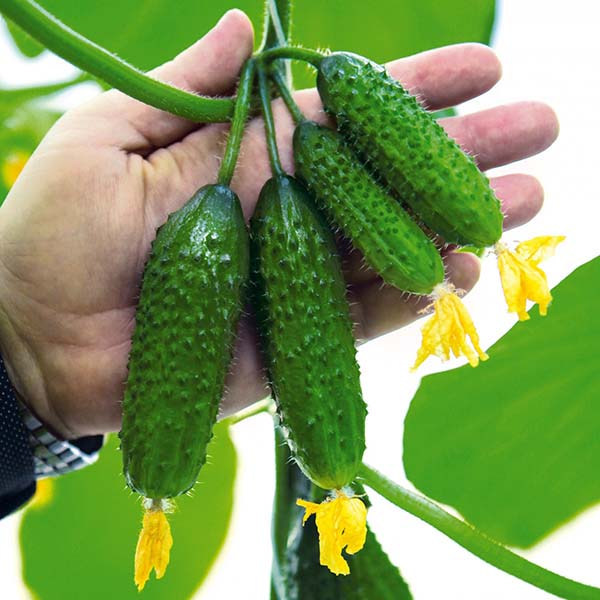
Content
- 1 What are bunch (bouquet) cucumbers and what are the advantages of growing them
- 2 Features of growing cucumbers of bunch-type fruiting
- 3 How to form bunch cucumbers: rules for pinching and pinching
- 4 The best bunch cucumbers
- 5 Parthenocarpic bunch cucumbers: top-21
- 6 Bee-pollinated bunch cucumbers: top-4
What are bunch (bouquet) cucumbers and what are the advantages of growing them
Bunch cucumbers got their name due to the fact that they form in each internode several ovaries at once (from 3 to 10 or more)which, when ripe, form bundles of zelents.
By the way! Cucumbers that have 8-10 or more ovaries, called superbeam.
Have common varieties or hybrids of cucumbersin leaf axils, as a rule, 1-2 inflorescences are formed.
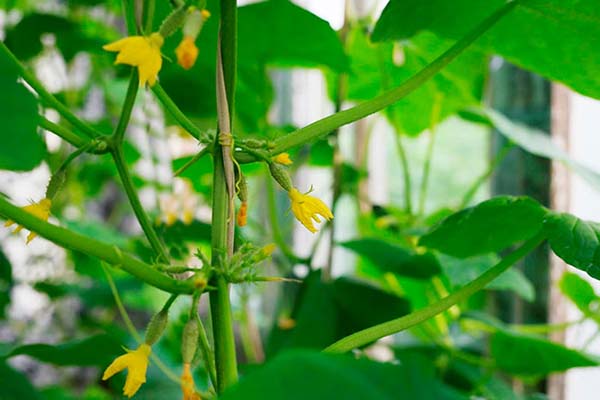
Interesting! Bunch cucumbers are also often called bouquet, because in the process of flowering, they form many flowers growing from one place (node), which is very similar to a bouquet. Therefore, this type of flowering is usually called bouquet.
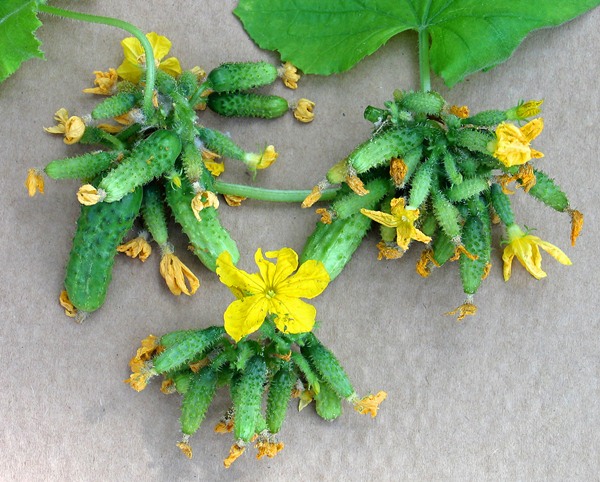
Interesting! Bosom is called the place where the leaf leaves the stem. In this place there is a bud, from which either an shoot or a flower (ovary) can grow.
The advantages of growing bunch cucumbers are:
- High yield due to the large number of ovaries.
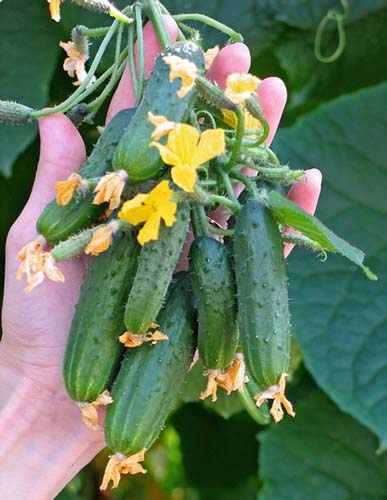
One plant with a bundle type of fruiting is capable of producing a yield comparable to 2-3 ordinary plants.
- Mass ripening - simultaneous pouring of fruits.
- Zelentsy are small in size, as a rule, they are gherkins or pickles. In other words, they are ideal for pickling and canning.
Features of growing cucumbers of bunch-type fruiting
If you do not properly care for bunch cucumbers (follow the cultivation techniques), then you can not even dream of high yields.
The nuances of agricultural technology for growing bunch cucumbers are expressed in the following (perhaps, in some sense,can be called disadvantages):
- Required good and uniform illumination, stable temperature conditions.
- High demands on moisture and nutrition - they are needed water more often and feed regularly (at least 1 time per week, preferably with complex mineral fertilizers such as Aquarin, Master, Fertika, which was formerly called Kemira). Also initially required exclusively fertile and loose soil.
Important! If you do not regularly feed the plants, you will lose a lot of ovaries, which will begin to turn yellow and dry.
Potash fertilizing is especially important, but nitrogen fertilization during the period of ovary and fruiting is contraindicated.
- Needed constant collection of fruits - every other day or even every day.
Note! If you come to the dacha only for the weekend, then 1-2 greens in each bunch will outgrow, and the rest of the ovaries will lack moisture and nutrition. Because of this, they will begin to turn yellow and dry, in other words, overgrown fruits will hold back the filling of new ones.
Therefore, in order to realize the main advantage of growing bunch cucumbers, it is recommended to collect green leaves as often as possible and at a younger stage of green leaves (pickles or gherkins). Only in this case practically all ovaries will be able to develop and to a lesser extent the natural discharge of the ovary will take place.
Thus, many gardeners agree that bundled varieties of cucumbers are, rather, for those who either live in the summer in the country, or grow them on the backyard of a private house. However, there are varieties with a bundle type of ovary laying that do not require such frequent care.
By the way! Indeed, many gardeners complain that with bunch cucumbers too much trouble (for example, it is banal in bunches it is not very convenient to harvest, because neighboring ovaries can be easily damaged), and it is much easier to grow ordinary varieties (hybrids), getting, in general, a similar harvest.
Video: features of growing bunch cucumbers
Note! The number of ovaries per node can vary depending on growing conditions and the location of the node on the plant.
Even in the most superbeam hybrids, the number of ovaries per node on a plant can vary from 2-4 to 10-11 and more.
Reduce the number of ovaries:
- excess nitrogen supply;
- overdrying the soil;
- strong overheating;
- excessive shading.
This is noticeable in the case of very rapid growth of the main stem (the so-called effect "Resorption of bundles"). In the lower nodes of the main stem, there may be more ovaries than in the nodes of the middle tier when overfeeding plants in hot weather.
Under optimal conditions, when the growth of plants is not too fast, the number of ovaries in a node increases from the lower nodes to the upper ones and from the main stem to the lateral shoots. Relatively low air temperature, mainly at night (the soil temperature should be optimal: from +21 to 24 degrees), optimal conditions for the growth and development of plants contribute to an increase in the number of ovaries in the nodes.
By the way! The largest beams formed under the trellis, and on well-lit side shoots.
How to form bunch cucumbers: rules for pinching and pinching
Cucumbers with bunched ovaries must be shaped, which can be done according to the following scheme:
By the way! Formation is also necessary so that the plant does not shade itself.
- from 0 to 50 cm (zone 0, first 3-4 knots) - holdblindness those. you need remove all the rudiments of lateral shoots and ovaries up to 4-5 leaves, whileleaves all must be left.
Important! Blinding the lower part of the bushes must be carried out for all types of cucumbers.
Moreover, this operation follows perform as early as possible, required before blooming flowers in blinding knots.

- From 50 cm to 1 meter (zone 1, next 3-4 knots) - you need remove all side shoots, leave 1 ovary (bunch) for 1 sheet (not an escape, namely a leaf).
- from 1 meter to 1.5 meters (zone 2, next 3-4 knots), pinch all the following side shoots after 2 leaves, i.e. each should have 2 leaves and, accordingly, 2 ovaries (1 ovary = 1 sheet).
- from 1.5 meters to 2 meters or to the end of the trellis (zone 3), pinch all side shoots after 3 leaves, i.e. leave 1 ovary (bunch) for each 1 sheet, i.e. in total there should be 3 bundles and 3 sheets.
- from 2 meters (from the end of the trellis) and to the side (zone 4), similar to the 1st zone, the main lash needs to be pinched after 3-4 sheets, leaving 1 ovary (bunch) for each leaf (3-4 bunches and 3-4 leaves).
Important! The producer of seeds on the package may suggest a different scheme for the formation of cucumber bushes. You should stick to it.
Alternative schemes for the formation of cucumbers with a bouquet type of fruiting:
By the way! The following schemes are more suitable for superbundled cucumbers, in which more than 8-10 ovaries are laid.
And the next video shows another scheme for the formation of bundled cucumbers.
Video: how to form cucumbers with bundle ovaries
The best bunch cucumbers
Naturally, not all varieties, or rather, mostly hybrids of bunch cucumbers, are the same, so you need to choose a specific variety for yourself and your conditions so that the result obtained can meet your expectations as much as possible.
Next, a list of the best bunch cucumbers will be presented, prepared on the basis of the degree of popularity of the names of hybrids, an analysis of the reviews of experienced gardeners, as well as the personal opinion of the author.
By the way! Cucumbers with bundled ovaries are like parthenocarpic (self-pollinating, or rather "not requiring pollination"), and bee-pollinated.
Parthenocarpic bunch cucumbers: top-21
It is not surprising that it is precisely parthenocarpic cucumbers, including this applies to bunch-type hybrids of fruiting.
As a rule, parthenocarpic cluster hybrids are intended for cultivation in a greenhouse, but many varieties of cucumbers are also excellent for outdoor cultivation.
So, a list of the most popular (best) parthenocarpic bundle cucumbers (alphabetically):
Herman F1

- Early maturing parthenocarpic hybrid, fruiting in 40-45 days from germination.
- The plant is determinate, medium-sized.With bunched ovaries. With sufficient nutrition, it forms 6-7 fruits on each node.
- It is intended for growing in open ground, under temporary film shelters, as well as in protected ground (film greenhouses).
- Fruits are dark green, flattened, cylindrical, tuberous, with white pubescence.
- Length - 10-12 cm, diameter - 2.9-3.1 cm, weight - 70-90 g.
- Productivity - up to 8.5-9 kg per square meter.
- Taste good or great. There is no bitterness.
- Universal use: perfect for pickling, pickling and fresh consumption.
- Resistant to cucumber mosaic virus, cladosporium and powdery mildew.
Garland F1
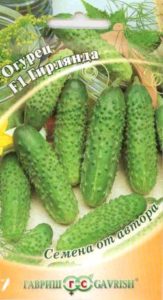
- Early maturing parthenocarpic hybrid, fruiting 45-50 days after germination.
- Plant with vigorous growth, slightly branched. Form into one stem. With bouquet (bundle) setting of ovaries (up to 4-5 in one node).
- For growing in a film greenhouse.
- Shade-tolerant, so it can be grown on a balcony, loggia or indoors.
- Fruits are dark green, often lumpy, whitish,
- Length - 12-14 cm, weight - 120-130 grams.
- Productivity - up to 14-16 kg per sq. meters.
- Excellent taste and aroma. Fruits do not turn yellow, retain their presentation for a long time.
- Universal use: perfect for pickling, pickling and fresh consumption.
- Relatively cold-resistant.
- Resistant to root rot, powdery mildew, olive spot, relatively resistant to downy mildew.
Gunnar F1

- Early ripe parthenocarpic hybrid (from germination to the beginning of fruiting 38-40 days.).
- The plant is indeterminate, compact, with short lateral shoots, bouquet (bunch) type of flowering (up to 4 ovaries in one node).
- For growing in plastic greenhouses and open field.
- The fruit is dark green, short, fusiform, large tuberous.
- Length - 8-12 cm.
- Excellent taste. No bitterness.
- Productivity - up to 20.8 kg per sq. meter.
- Universal use: salad, canning.
- Resistant to powdery mildew, cladosporium disease, cucumber mosaic virus.
Emelya F1

- An early ripening parthenocarpic hybrid, begins to bear fruit on days 39-43 after full germination.
- Female or predominantly female flowering type
- The plant is indeterminate, vigorous, medium-branched, with bundled ovaries.
- For spring greenhouses, tunnels, open ground.
- Fruits of intense green color, large lumpy white thorns, oval-cylindrical shape,
- Weight - 120-150 g, length - 13-15 cm, diameter - 4.0-4.4 cm.
- Very high taste, excellent for pickling and preserving.
- Productivity - 12-16 kg per square meter.
- Increased cold resistance. Resistant to olive spot, cucumber mosaic virus, root rot and powdery mildew tolerant.
Zyatek F1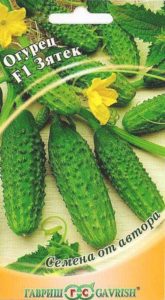
- Early ripening parthenocarpic hybrid (45-48 days from germination to fruiting)
- The plant is indeterminate, medium-branched, has a strong root system, intensive growth. Bouquet type of flowering (bundle ovary formation). In the axil of leaves 2-4 ovaries are formed (up to a maximum of 6-8 ovaries).
- Designed for growing in open ground and film greenhouses.
- The fruit is dark green with light stripes, cylindrical, tuberous, white-thorn.
- Length - 10-12 cm, diameter - 3.0-3.5 cm, weight - 90-100 g.
- Productivity - up to 5.0-7.0 kg per 1 plant or 13.2 kg per square meter.
- The taste is excellent. No bitterness.
- The use of fruits is universal (fresh, salting, pickling).
Can be harvested for pickles and gherkins.
- Resistant to root rot, powdery mildew, resistant to downy mildew.
Emerald F1 earrings
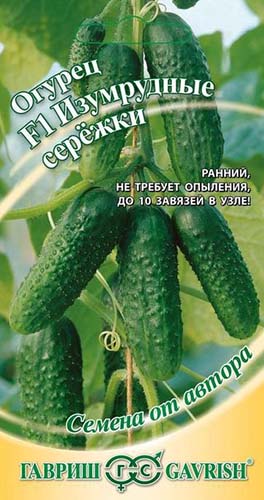
- Early ripening parthenocarpic hybrid (42-47 days from germination to fruiting).
- The plant is indeterminate, vigorous, medium-branched. With a bouquet (bundle) arrangement of ovaries (up to 8-10 per knot).
- For cultivation in greenhouses, under temporary cover films and in the open field.
- Fruits are cylindrical, dark green, with frequent medium-sized tubercles, white thorns.
- Length - 9-11 cm, diameter -3.0-4.0 cm, weight - 100-110 g,
- Productivity - 11-12 kg per square meter.
- Universal use: salad, canning.
Ideal for picking pickles and gherkins.
- Resistant to powdery mildew, olive spot, relatively resistant to downy mildew, root rot and bacteriosis.
Claudia F1
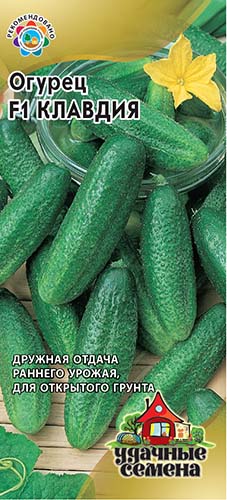
- Early maturing parthenocarpic hybrid.
- The plant is climbing, with a bouquet (bundle) setting of ovaries (more than 3 in a node).
- For growing outdoors under temporary cover films.
- The fruit is cylindrical, small tuberous, green to dark green, with short stripes, white pubescence.
- Length - 10-12 cm, diameter - 3-4 cm, weight - 64-89 g.
- Productivity - up to 2.1-4.8 kg per sq. meter.
- Recommended for pickling and pickling, suitable for fresh consumption.
- It has a complex resistance to the main diseases of cucumbers.
Connie F1
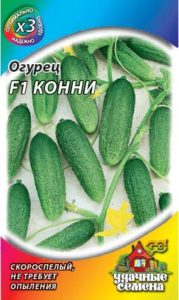
- Early ripening parthenocarpic hybrid (from germination to fruiting 47-50 days).
- The plant is indeterminate, vigorous, medium-growing, medium-leafy, with a tendency to bunched ovaries.
- For growing in film greenhouses.
- The fruit is cylindrical, very short, green, small and tuberous, with white pubescence.
- Length - 7-9 cm, weight - 60-82 g.
- Productivity - up to 12.6-16.0 kg per sq. meter (at the beginning of fruiting to early - 8.7-9.2 kg).
- The fruits are delicious and aromatic.
- Universal use: salad, canning.
- Resistant to powdery mildew and root rot.
Grasshopper F1
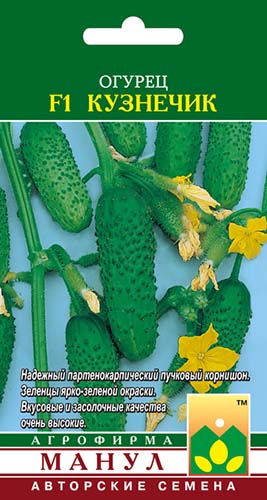
- An early ripening paternocarpic hybrid, begins to bear fruit on 39-42 days from germination.
- The plant is indeterminate, vigorous, branching is limited. The bundle of ovaries is formed in the nodes from 2-3 to 4-6 ovaries.
- Designed for growing in open and protected ground.
- Fruits are large tuberous, white-spiked, bright green in color, pubescence is frequent.
- Weight - 90-110 g, length - 10-12 cm, diameter - 3.2-3.5 cm.
- Productivity - up to 10-14 kg per sq. meter.
- Salting and canning qualities are very high.
- Resistant to powdery mildew, olive spot, cucumber mosaic virus, tolerant to downy mildew.
Courage F1

- Early ripening parthenocarpic hydride, from germination to fruiting 45-50 days.
- Designed for growing in film greenhouses.
- Plants are indeterminate, vigorous, shoot-forming ability is average. With bundle ovaries, 2-4 ovaries are formed at the nodes (up to 5-6 ovaries).
- The fruit is dark green, with light stripes, lumpy, whitish.
- Length - 12-15 cm, diameter - 4.0-4.5 cm, weight - 120-130 g.
- Productivity - 6-8 kg per plant or up to 16-18 kg per square meter.
- Taste good and excellent, without bitterness.
- Universal use (for salad and canning).
- Relatively resistant to major diseases.
Boy with thumb F1
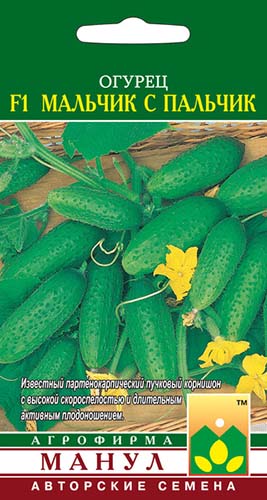
- A very early ripening parthenocarpic hybrid, begins bearing fruit on the 37-39th day from germination.
- The plant is indeterminate, vigorous, medium-growing. The bundle of ovaries is formed in the nodes from 2-3 to 5-6 ovaries.
- For open ground, spring greenhouses and tunnels.
- The fruits are lumpy, white-thorny, bright green, with frequent pubescence, but the thorns are not thorny.
- Length - 6-10 cm, weight - 50-65 g.
- Productivity - 10-13 kg per square meter.
- Universal use: salad, pickling. The taste is high.
- The hybrid is resistant to powdery mildew, olive spot, cucumber mosaic virus, tolerant to downy mildew.
Marinda F1
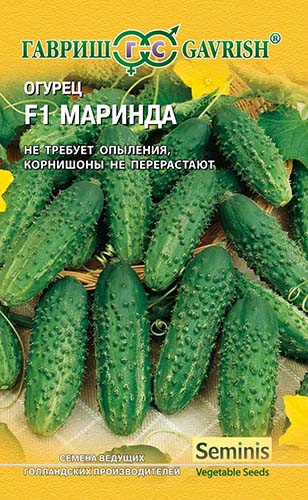
- Early maturing parthenocarpic hybrid.
- The plant is medium-sized. With sufficient nutrition, up to 6-7 ovaries are formed in each node (prone to bundle arrangement of ovaries).
- For cultivation in greenhouses and open field.
- Fruits are dark green, lumpy, with white thorns,
- Length - 8-10 cm.
- The fruits are delicious and crispy.
- Universal use: for fresh consumption, pickling and pickling.
- Resistant to major cucumber diseases and unfavorable growing conditions.
Maryina Roshcha F1
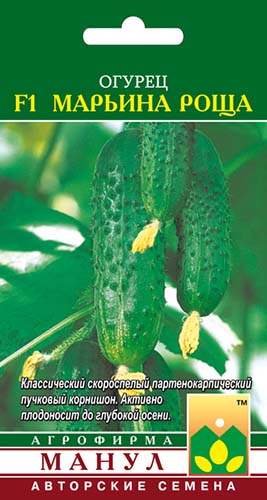
- Early maturing parthenocarpic hybrid. It starts bearing fruit on the 39-42nd day after full germination.
- The plant is indeterminate, vigorous, with good regrowth of lateral shoots. With bundled ovaries, from 2-3 to 4-5 ovaries are formed at the nodes.
- For open and protected ground.
- Fruits are intensely green in color, lumpy, white-thorny, dense, tubercles are large, the location of tubercles is medium-frequent.
- Weight - 100-110 g,length - 10-12 cm, diameter - 3.0-3.4 cm.
- Productivity - 10-13 kg per square meter.
- Salting and taste qualities are high. Very aromatic and crispy.
- Cold-resistant and shade-tolerant. Resistant to powdery mildew, olive spot, cucumber mosaic virus, tolerant to downy mildew, root rot.
Fruiting until late autumn.
Masha F1

- Early maturing parthenocarpic hybrid, fruiting occurs 37-39 days after germination.
- The plant is determinate, medium-sized, with limited shoot-forming ability. With bunched ovaries. With sufficient nutrition, the plant forms up to 6-7 fruits in each node.
- Suitable for growing in the open field and under a film cover.
- Fruits are cylindrical, leveled, dark green, lumpy, whitish.
- Length - 8-9 cm, diameter - 3.0-3.5 cm.
- Productivity - up to 10-11 kg per sq. meters.
- Excellent taste. Without emptiness and bitterness.
- Universal use: for fresh consumption and canning.
- Resistant to cucumber mosaic virus, downy mildew and downy mildew, cladosporiosis.
Ant F1
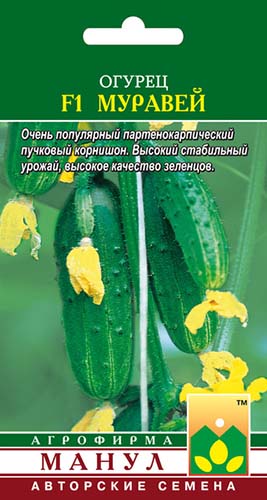
- Early ripening parthenocarpic hydride (begins to bear fruit 37-38 days after germination).
- The plant is indeterminate, the vigor of growth is medium, weakly branched, bundle formation of ovaries (from 2-3 to 5-7 ovaries are formed at the nodes).
- For growing under cover films.
- The fruit is oval, green with stripes of medium length, slightly ribbed, tubercles are large, medium density, pubescence is white
- Weight - 100-110 g, length - 8-11 cm, diameter - 3.0-3.4 cm.
- Productivity - up to 10-12 kg per square meter.
- Salting, taste and canning qualities are very high.
- Universal use: salad, canning.
- The hybrid is resistant to powdery mildew, olive spot (cladosporium), the common cucumber mosaic virus, and is tolerant to downy mildew.
Active formation of zelents due to a strong parthenocarp is observed from the lowest nodes of the stem in almost any weather conditions.
Goosebump F1

- Early ripening parthenocarpic hybrid (43-48 days from germination to fruiting).
- The plant is indeterminate, vigorous, medium branching. Bouquet type of flowering (bundle ovary formation). 4-6 ovaries are formed in each axil of the leaf.
- It can be grown both in protected ground (film greenhouses) and in open ground under temporary film shelters.
- Fruits are dark green, short, cylindrical, with large wide tubercles, black thorns.
- Length - 11-13 cm, diameter 3.5-4 cm, weight - 90-110 g.
- Productivity - 6-7 kg per 1 plant or up to 10.3-12.0 kg per sq. meter.
- The taste is excellent.
- Universal use: for pickling, pickling, salads.
Great for cask pickling.
- Resistant to powdery mildew, relatively resistant to downy mildew and root rot.
Prestige F1

- Early maturing parthenocarpic hybrid (42-45 days).
- The plant is indeterminate, medium-sized, medium-growing, with a bundle arrangement of ovaries (up to 3-4 in one node).
- For growing in the open field and under film shelters.
- The fruit is short, cylindrical, large tuberous, dark green with short stripes, with white pubescence.
- Length - 8-10 cm, weight - 65-90 grams.
- Productivity - up to 25 kg per sq. meters.
- The taste is good and excellent.
- Mostly canned food, but will also work for salads.
- Resistant to disease and stress: temperature extremes and darkening.
Pace F1
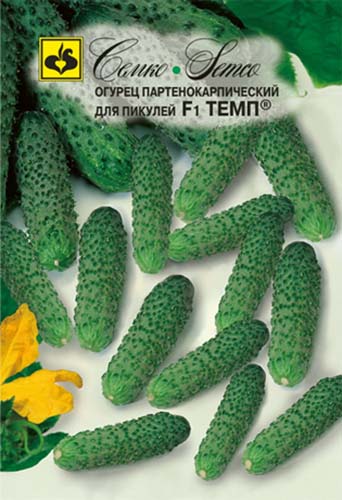
- An early ripening parthenocarpic hybrid, begins to bear fruit on 42-44 days after full germination (pickles in 37-38 days).
- The plant is indeterminate, weakly branched, characterized by bundle fruiting, the number of female flowers in a node is 3 or more (4-5).
- For growing under cover films.
- The fruit is very short with a short neck, cylindrical, dark green with stripes of medium length, tuberous, pubescence is white, of medium density.
- Length - 5-9 cm, diameter - 1.6-2 cm, weight - 70-80 g.
- Productivity - up to 11-15 kg per square meter (average - 14.3 kg per square meter), when picking pickles - up to 5-7 kg.
- The taste is excellent. No bitterness.
- Universal use: salad, canning, pickling.
Ideal for picking pickles.
- Resistant to cladosporiosis, powdery mildew, tolerant to downy mildew and cucumber mosaic virus.
Mother-in-law F1
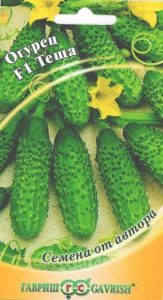
- Early ripening parthenocarpic hybrid (45-48 days from germination to fruiting).
- The plant is indeterminate, medium-branched. Bouquet type of flowering (bundle ovary formation). Up to 3-4 ovaries are formed in the leaf axil.
- Designed for growing in open ground and film greenhouses.
- The fruit is dark green, cylindrical, lumpy, brownish.
- Length - 11-13 cm, weight - 100-120 g,
- The yield of one plant is up to 5.5-6.5 kg or up to 12.2 kg per square meter.
- The use of fruits is universal: fresh, salting, pickling.
- Fine, delicate taste. No bitterness.
- Cold resistant.
- Possesses complex resistance to the main diseases of cucumber (resistant to powdery mildew, tolerant to downy mildew).
Furor F1
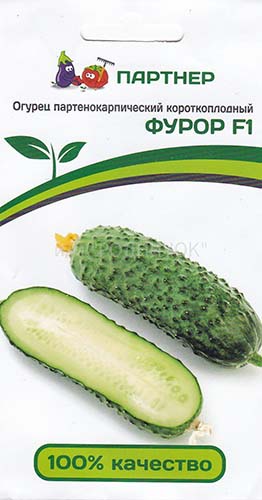
- Very early parthenocarpic hybrid, from germination to fruiting 37-39 days.
- Plants with a strong root system and short side shoots. Bouquet (bunch) type of flowering (2-4 fruits are tied in a knot).
- Recommended for greenhouse cultivation, but also suitable for planting in open ground.
- Fruits are dark green, without stripes, well pinned.
- Length - 10-12 cm, diameter - 3 cm, weight - 63 grams.
- Productivity - more than 20 kg per square meter.
- High taste.
- Ideal for pickling.
- Resistant to olive spot (cladosporiosis), powdery mildew and cucumber mosaic virus.
Shosha F1

- Early maturing parthenocarpic hybrid, fruiting occurs 39-43 days after germination.
- The plant is indeterminate, medium-branched. The bundle arrangement of the ovaries, up to 3 ovaries are formed in the knot.
- For growing in the open field and under temporary film shelters, as well as in closed ground (greenhouses).
- The fruit is green, cylindrical, medium lumpy, with thorns and pubescence.
- Length - 9-11 cm, diameter - 3-3.5 cm, weight - 50-80 g.
- Productivity - up to 14.5 kg per sq. meters.
- The taste is good.
- Mostly for salad purposes, but also suitable for canning.
- Resistant to major diseases: common cucumber mosaic, powdery mildew, target leaf spot and cucumber vein yellowing virus.
Other parthenocarpic hybrids of cluster cucumbers
Note! If a firm sells seeds, then it is not necessarily the originator.
- Firm"Aelita" sells a huge number of parthenocarpic hybrids of cluster cucumbers: Antoshka F1, Grandma's secret F1, Barin F1, Chipmunk F1, Vanyusha F1, Funny gnomes F1, All the way F1, All in a beam F1, Brownie F1, F1 Buddies, Hedgehogs F1, Casper F1, The Little Humpbacked Horse F1, Baby Raccoon F1, Round Harvest F1, Kuzya F1, Crunchy babies F1, Summer Resident Dream F1, Mustang F1, Our Masha F1, Sissy F1, An extraordinary miracle F1, Petruha F1, Beam charm F1, Beam Troopers F1, Five Stars F1, Russian appetizer F1, Seven Dwarfs F1, Temptation F1, Styopka F1, Superklush F1, Supercrust F1, Ural Gherkin F1, Khrustikov F1, Khrustichok F1, Crunchy cellar F1,Espagnolette F1.
- The firm is not far behind "Manul": Anyuta, Heroic Power, Be Healthy, Petrel, Brawler, Green Wave, Emerald City, Toaddy, Labyrinth, Matryoshka, Junior Lieutenant, Dragonfly, Three Tankers, Hit of the Season, Clean Ponds, Focus (all with good or strong branching) and many others (with limited and weak branching).
- Of course, the seeds of parthenocarpic hybrids of cluster cucumbers are also sold by other well-known seed producers, such as Gavrish, Partner, Sedek, Semko, Search and other agricultural firms.
Video: the best cucumbers of the bunch type of fruiting (a review of hybrids from the company "Aelita")
Bee-pollinated bunch cucumbers: top-4
Bee-pollinated hybrids and varieties now they are not so popular, but many gardeners are happy to grow exactly these cucumbers of a bouquet type of flowering and manual fruiting.
Bee-pollinated, including bunch cucumbers, are primarily intended for open ground, but they can be quite successfully grown in a greenhouse.
List of the most popular (best) bee-pollinated bundle cucumbers (alphabetically):
Pet F1
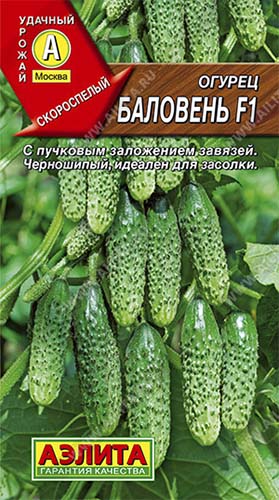
- Early maturing bee-pollinated hybrid. Fruits 45-47 days from germination.
- The plant is indeterminate, vigorous, highly leafy, with medium branching. With bunched ovary - 2-3 ovaries are formed in one node.
- For open ground and plastic greenhouses.
- Fruits are oval, large lumpy, black-spiky.
- Length - 8-10 cm, diameter - 2-3 cm, weight - 80 g.
- Productivity - up to 15-16 kg per sq. meter.
- Excellent taste, fruits are fragrant, crispy, without bitterness.
- For universal use, with excellent pickling qualities.
Loyal friends F1

- Early maturing bee-pollinated hybrid. It starts bearing fruit on the 37-39 day after germination.
- The plant is climbing, indeterminate, weakly growing, mainly of the female flowering type. Bundle ovary from 2-3 to 5-8 or more ovaries are formed in the nodes.
- For open ground, tunnels, spring greenhouses.
- The fruits are tuberous, black-spiky, oval-cylindrical in shape.
- Length - 8-10 cm, diameter - 3.5-4.1 cm, weight - 90-105 g.
- Productivity - up to 2.5-3 kg per sq. meter (in the open field).
- Salting and taste qualities are very high.
- Cold-hardy, resistant to olive spot, cucumber mosaic virus, powdery mildew and downy mildew tolerant.
Kids on the F1 branch

- Early maturing bee-pollinated hybrid (from germination to the beginning of fruiting 42-45 days).
- The plant is indeterminate, vigorous, medium-branched, predominantly female flowering type. Bundle ovary, in the bosom of each leaf, 2-3 cucumbers are simultaneously formed.
- Recommended for growing in open ground and under cover films.
- The fruit is short, cylindrical, small tuberous; pubescence is white, dense.
- Weight - 90-100 g.
- Productivity - up to 10-11 kg per sq. meter (in the greenhouse).
- Excellent taste, not bitter, no voids, juicy and crunchy.
- Universal use: great fresh, in salads, perfect for all types of pickling and pickling.
Finger
Note! This is a variety, not a hybrid.
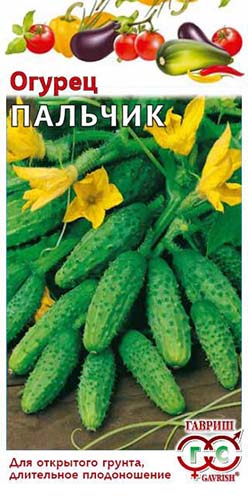
- Early maturing bee-pollinated grade (44-46 days from germination to fruiting).
- The plant is indeterminate, strongly plaited, medium-branched, with a bundle of ovaries.
- Recommended for outdoor cultivation.
- The fruit is elongated-cylindrical, dark green, with medium-length stripes and weak spotting, large tubercles, sparse tubercles, white pubescence.
- Length - 9.2-12.7 cm, diameter - 2.7-3.4 cm, weight -114-120 g.
- Productivity - 1.8-2.9 kg per sq. meter (in the open field).
- The taste is excellent.
- Universal use: for preparing salads, canned food, pickling.
- Differs in long-term fruiting - more than 60 days.
- Tolerant to downy mildew.
Other bee-pollinated beam hybrids and varieties
Note! If a firm sells seeds, then it is not necessarily the originator.
- Firms "Aelita": Afonya F1, Eroha F1, Ira F1, Coryphaeus F1, Pet F1, Salt F1 himself, Three comrades F1, Crunch F1.
- Firms "Manul": Alphabet F1, Acorn F1, Captain F1, Compass F1, Teremok F1, Saltan F1.
By the way! Beam hybrids Captain and Acorn have a valuable feature - a slow filling of fruits, which prevents their outgrowth with rare harvests. This feature will be especially valuable for gardeners who come to garden plots only on weekends.
- Of course, the seeds of bee-pollinated hybrids and varieties of bunch cucumbers are also sold by other well-known seed producers, such as Gavrish, Partner, Sedek, Semko, Search and other agricultural firms.
Well, now you know what bunch cucumbers are or, as they are more correctly called, cucumbers with a bouquet type of flowering or a bunch type of fruiting (sometimes they also say “with a bunch arrangement of ovaries”). Indeed, the agricultural technology of growing them requires a slightly greater intensity of care, but all your costs will be fully justified when you start harvesting. Although difficulties may arise here, you will have to do this almost every day (however, this is in some sense an advantage). You just have to decide on the varieties (hybrids) you like the most and purchase them in a trusted store.


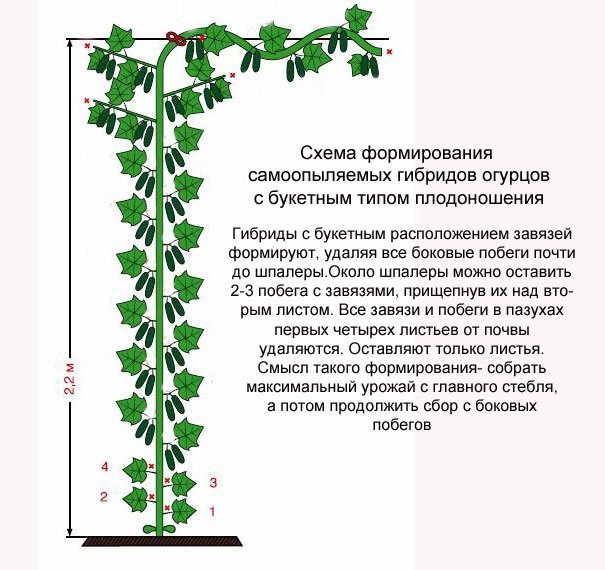

Hello! Quite helpful article. Everyone wanted to try cucumbers with bundled ovary formation, but did not dare. There was little information. And there is so much and so much detail!
Try it! The main thing is to regularly feed, water and pick the fruits.